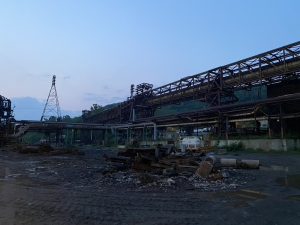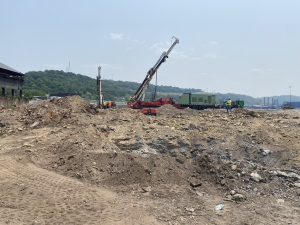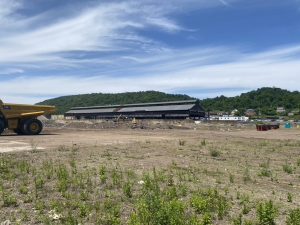The Vision of Restoration
The Vision of Restoration
Dylan Ilov
The Vision of Restoration
Oftentimes the viewpoint of the construction industry from the outside is negative. The main common practice is taken as knocking things down and leaving the earth messy and overturned. Although the provided imagery may look like an exact example of this, there is a deeper meaning to the hauling of this dirt. Dan, in his early thirties, is my Project Manager at my extended summer internship/ job. Dan, with a degree in Environmental Science, captured the included images with the intent of showing the importance of this project through both environmental and cultural development. The project is in Weirton, West Virginia, a town rooted in and hanging on to the last of the dying American steel industry. The purpose of the job is to build a manufacturing plant for the missing piece to the reliable sustainable energy grid. Through Dan’s impressive beginning to a successful career in the construction industry he has run many projects for numerous purposes, but he has never been as proud of the work he gets to engage in than he is for this project. In sharing these pictures, Dan strives to reveal the impact that this project will have on West Virginia’s economy and more importantly their cultural direction in pushing to be a part of the progress of the renewable energy industry. 
“As long as I or anyone around me can remember, Weirton has been known as town built on steel, and if you ask anyone living here, they’ll tell you that loud and proud. The unfortunate truth is that the American steel industry grows smaller and smaller year by year, and in parallel so has Weirton. The site that Dylan and I stand on was a steel mill in its past life, and before that a steel mill, and before that… well I think you get the idea. Shown in the picture is large infrastructure built to connect utilities to several surrounding mills, only one still active. Below shows a small portion of the demolition that has occurred throughout the 55-acre site to clear all inactive mill equipment, demolition that lays the path for the next step of this site and the next step for Weirton.”
Dan’s selected image resonates with me because it shows what this town stands for. Even though most of the infrastructure will get knocked down and replaced, the standing structure and structures around it will continue to stand as relics to appreciate what built this city. This connects to me also because my hometown, just up the river, experienced the same shutdown and turnover that I am currently a part of. My grandfather worked as a Foreman in the mill as well as his brother and friends, and it was always easy to see how proud they were of the work they accomplished. To be able to help construct the first wave of the next generation’s working culture, especially through renewable energy, helps me appreciate the impact that one building can have on a town’s culture.

“Here we see several drill rigs and a trench compactor, tasked with repairing the underground before a new building pad is constructed on top. The drill rigs boar probe holes into the ground where future foundation piles will be placed, and if a metal or environmental “obstruction” is encountered within 25 feet of ground level the location must be excavated to remove the obstruction. Once excavated, dirt fill is loaded back into the hole little by little and ran over by the trench compactor to abide by geotechnical regulations. The importance that these machines show from a restoration standpoint is how the redevelopment of this land is also meant to repair the sublayers that were buried as one mill was built atop the last. In the process of drilling an excavation, multiple locations have been found with oil in the ground and large several ton pieces of steel from “bad batches” that were dumped due to it being inadequate for commercial use. The mess that lies underground shows the little to no environmental regulations that were in place or even understood when the past mills were constructed. In taking these precautionary steps, we are cleaning the past to make for an even cleaner future.”
Dan’s crash course on the preliminary steps for a building foundation shows an important emphasis that modern construction has on cleaning an area before adding to its footprint. I also respect the fact that most of the objects we find in the ground; railroads, steel plates, copper wire lines, etc., will be recycled. These obstructions that we find underground would have just sat still adding to the dirty human footprint that has been placed on the earth, but now they can be used in new production to lessen the need for mining and shipping materials around the country. Their removal will also improve soil quality around the future building, which sits within a mile of the Ohio River. The improved soil quality will help re-introduce native vegetation and bring cleaner storm runoff, which in turn will minutely improve the water quality of the local aquifer.

“In front stands the site location for the future building and above that sits an old piece of the mill and the surrounding residential community. This image shows how connected the community is with the old mill location and the connection it will have with the new manufacturing plant. The proximity of the plant to the residential areas shows how important it is to have clean manufacturing in this spot. For around a century, this area has been exposed to poor air quality through being hit directly by the high carbon emissions and dust from the past mills. In installing the new, renewable manufacturing facility, the community will get to return proud of their growing industry while living in a healthier area.”
Dan brings up a great point as he emphasizes the importance of pride in the Weirton community. I also think that it’s important to note that under contract the plant is required to employ at least 750 people at a time after its complete opening. This will boost the morale of the town and more importantly it will open the doors to many currently unemployed members of the community. This easily is the biggest win and motivation that the project presents. A lot of people around the world don’t have access to proper air quality due to environmental injustice, which is better defined as, “Intentional or unintentional placement of low-income communities in proximity of environmentally hazardous or degraded environments, such as toxic waste, pollution and urban decay.” (2) The houses behind the old mill have experienced environmental injustice because of the past manufacturing that happened right next to them. The implementation of a green manufacturing facility brings environmental justice to this neighborhood through cleaner air quality and healthier water.
Through Dan’s selected images and statements, restoration is the clear outlier as the pressing theme. In this project that we are both immersed in, the cultural and environmental restoration that is presented makes the job worth while. The excitement and growth of the Weirton community in having a new wave of industry while holding onto their much deserved grit shows a wonderful communal development. In addition to cultural changes and growth, the project is also beneficial because of its environmental benefits in refurbishing barren land and healing it of its many underground obstructions. Audre Lorde is quoted in “Poetry is Not a Luxury” as often saying, “for each of us there is a place where our true selves are hidden and growing, ‘beautiful and tough against our nightmare of weakness’.” (1) Lorde may be generally directing her words towards poetry, but the same can be said for the community and the site that we work on itself. By uncovering and cleaning dirt washed in pollution and history, it can be seen how this town’s community is “growing” and returning to its old charisma though it may have laid “hidden” for a few decades.
References
- “Poetry Is Not a Luxury.” Canvas Webcourses, webcourses.ucf.edu/courses/1429103/modules/items/16898251. Accessed 19 June 2023.
- “Environmental Justice.” Canvas Webcourses, webcourses.ucf.edu/courses/1429103/modules/items/16898322. Accessed 19 June 2023.
Media Attributions
- F5117D7F-A174-46AC-9CD7-6B8E2213299D_1_105_c
- C633D674-0699-48D1-B598-F4D96C885D5F_1_105_c
- FA6D2849-1B6B-4746-8052-5D30F88B1A20_1_105_c

